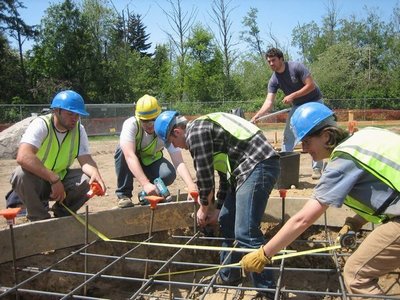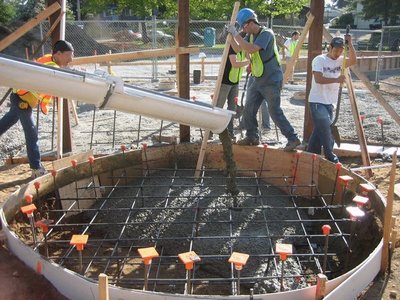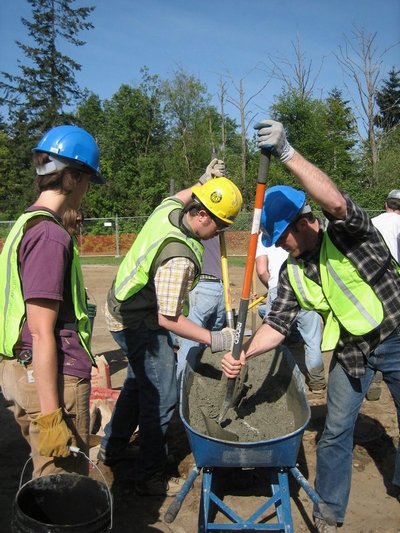May 31, 2007
White Center Heights: UW landscape architecture team creates gathering space for neighborhood
Soft, wet concrete slid into the curving channel like cake batter into a pan, and teams from the UW and King County smoothed it into place.
White Center Heights Park, in an unincorporated area southwest of Seattle, is getting a makeover.
“The park really created a partnership between a community in need and the University,” said Ralph Coolman, a senior lecturer who teaches urban planning at the UW. He, landscape architecture professors Jeff Hou and Daniel Winterbottom, and a group of their students have worked with the county and White Center residents to redesign the 5.6-acre park. What had been open, unimproved land west of SR-509 is getting a stage, a plaza, a picnic shelter and tables, community gardens, benches, sculpture and extensive landscaping.
Starbucks Coffee Co. donated $550,000 for the work, part of the Seattle-based company’s $1 million commitment to Puget Sound area parks in 2007.
The final week before the June 15 dedication, multiple teams will work on the park, including those from the UW, the county, the neighborhood and Starbucks. Company spokesman Heywood McGuffee said Starbucks focused on local parks because they, like coffee shops, are community gathering places.
White Center is home to a growing immigrant community and is one of the most ethnically diverse areas of the Seattle metropolitan area. At least 30 and as many as 50 languages are spoken in the area, and the diversity is expected to grow, according to Aileen Balahadia, executive director of the White Center Community Development Association.
Asians, many of them Vietnamese or Cambodian, constitute the largest group, Balahadia said, followed by African-Americans, Mexicans, Salvadoreans, Eritreans, Pacific islanders and Native Americans.
The White Center Community Development Association is managing the project, which officially began in January when Starbucks awarded the funds. The company asked that the project be finished in six months, which meant pulling the county, the UW team and the neighborhood together very fast. “We were really interested in getting a lot of public input on the design,” Balahadia added.
Community members wanted a space where they can come together. They also wanted some things that would address ethnic diversity. Eventually community gardens, an underground fire pit and a barbecue pit that can accommodate a whole pig became part of the design.
The park will also include educational signs near a wetland area. A picnic shelter, site of the concrete job in mid-May, will be covered by a butterfly roof which directs water into a cistern for the community gardens. To limit impervious surfaces, porous paving has been used in the shelter.
In a work area behind Gould Hall, Savannah Hines-Elzinga, a UW landscape architecture student, helped construct the wood form for the wall. The park project has provided real-world experience, she said, like worries about whether construction documents would match design and materials. (They have.)
At the park the morning of the concrete job, Winterbottom worked alongside his students. Early, before the cistern and wall were lined with concrete, he pointed to the empty forms: “Spray the wall and the cistern with water so the concrete doesn’t wick up too fast.” All told, Winterbottom and the other workers would lay and smooth about 9 cubic yards of concrete that Thursday morning.
Eventually, Hines-Elzinga and others, including community volunteers, will install a mixture of native and ornamental landscaping, including maple, apple and katsura trees; blueberry plants; and herbs such as sage, thyme and lavender.
Phase II of the park is tentatively scheduled to begin at the end of the summer and be completed in two to three years. The UW students, directed by Hou and with suggestions from the community, designed plans for an existing pond and wetland to be restored and enhanced. The state of Washington has earmarked $500,000 for Phase II.
The park is part of a larger collaboration with White Center Community Development. Coolman and his students have completed a plan that proposes projects in employment, housing, land use, downtown development, safety and civic capacity.
Meanwhile, however, the current project has had several memorable moments, including when Winterbottom took time from the concrete job to rummage in his blue jeans for a handful of coins.
Sun glinted on several as he tried to read mint dates. Finally, though, Winterbottom selected a 2007 quarter. He always deposits a coin in wet concrete so someday, when it wears out and is removed, folks will know when the concrete was laid.
But the coin varies from job to job, Winterbottom said. “It all depends on how much you want to spend.”
Note: If you’d like to help with the makeover June 8–14, contact laurie.clinton@metrokc.gov.





